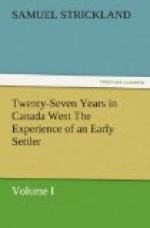Not many minutes after this occurrence, whilst descending a slight hill, I saw nine fine deer cross the road, within a short gun-shot of the spot where I stood. I had no gun with me; for I thought, if I did kill a deer, I should be obliged to leave it in the woods. Nothing further occurred till within a short distance of Trifogle’s, when a large wolf bounded close past me: he seemed, however, the more frightened of the two, which I was not at all sorry to perceive.
When I arrived at the tavern, I told Trifogle what I had seen. He said, it was very lucky I had not fallen in with the pack; for only the night before he had gone to a beaver-meadow, about two miles distant, to look for his working oxen which had strayed, when he was surrounded by the whole pack of wolves, and was obliged “to tree,” to save his bacon. He was, it seems, kept for more than three hours in that uncomfortable fix before he durst venture down—“when he made tracks,” as the Yankees say, “for hum pretty considerably smart, I guess.”
My solitary journey was performed in the fall of 1830: at the present time (1853) you may travel at your ease in a stage-coach and four horses, with taverns every few miles, and more villages on the road than formerly there were houses. Such are the changes that a few short years have produced in this fast-rising country!
CHAPTER XXII.
VISIT OF THE PASSENGER-PIGEON TO THE CANADAS. — CANADIAN BLACKBIRDS. — - BREEDING-PLACES OF THE PASSENGER-PIGEONS. — SQUIRRELS.
THE passenger-pigeon* visits the Canadas in the early spring-months, and during August, in immense flocks, bringing with them an agreeable change in the diet of the settler.
[* The passenger-pigeon is not so large as the wild pigeon of Europe. It is slender in form, having a very long-forked tail. Its plumage is a bluish-grey, and it has a lovely pink breast. It is, indeed, a very elegant bird.]
Persons unacquainted with the country and the gregarious habits of this lovely bird, are apt to doubt the accounts they have heard or read respecting their vast numbers: since my return to England I have repeatedly been questioned upon the subject. In answer to these queries, I can only say that, in some parts of the province, early in the spring and directly after wheat-harvest, their numbers are incredible. Some days they commence flying as soon as it is light in the morning, and continue, flock after flock, till sun-down. To calculate the sum-total of birds passing even on one day, appears to be impossible. I think, the greatest masses fly near the shores of the great Canadian lakes, and sometimes so low, that they may be easily killed with a horse-pistol, or even knocked down with a long pole.
During the first spring in which I resided at Goderich, the store-keeper was out of shot, and the pigeons happened to be uncommonly numerous. I had a large fowling-piece with a wide bore; so I tried a charge of fine shingle off the beach at the first flock that came within close range, and had the satisfaction of bagging seven birds at the first shot—indeed, it was almost impossible to miss them, they flew in such thick clouds. I have frequently killed on the stubbles, from twenty to thirty at one shot.




